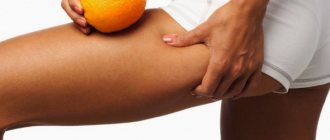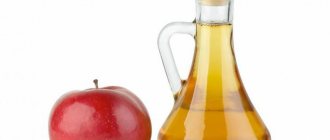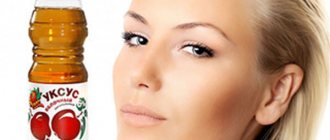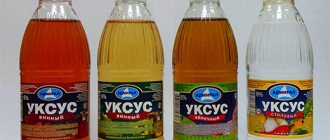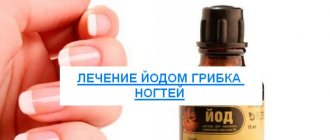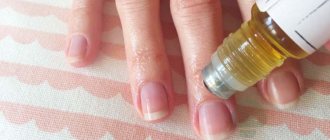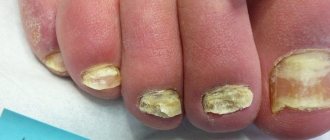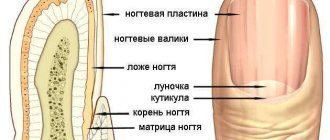At every step a person is surrounded by pathogenic bacteria. They can be in absolutely any place. On things in common use, in crowded areas, and ultimately on your hands. But dirty and wet things attract them most. Don't be afraid of these microorganisms. They are not immortal and can be easily removed with water and regular soap.
With proper prevention, a person will not succumb to infection. But if an infection does occur, it is necessary to quickly and correctly treat it. If fungal spores get on a person’s hands or feet, there is no time to waste and no discomfort to endure.
You should figure out how to treat nail fungus with vinegar essence and carry out all procedures responsibly.
How does vinegar affect mycosis?
Traditional medicine is rich in various ways to combat mycotic infections. Among the wide range of effective remedies, vinegar is the most popular - both essence and table and apple product. All of them have certain fungicidal and disinfecting effects.
It is not difficult to explain their activity against pathogens of onychomycosis and candidiasis. All fungi are “afraid” of an acidic environment, and when using vinegar, it becomes as saturated as possible, which is why therapeutic procedures with it are so popular and effective.
It is important to know!
When using vinegar against nail fungus, be sure to follow the following hygiene rules to avoid re-infection:
- Avoid wearing wet shoes. When your feet sweat, you need to wash and change socks often. Shoes that get wet in the rain should be changed quickly.
- When in a public place: swimming pool, locker room, etc., have your own slippers. Returning home, carry out procedures for nail fungus - a vinegar bath.
- Avoid wearing tight shoes.
- Buy shoes made from natural raw materials.
- Use cotton socks. Artificial materials contribute to the formation of fungus, as they interfere with normal air circulation and increase sweating.
The use of vinegar in folk medicine to treat onychomycosis is considered an affordable, safe method. There are almost no contraindications for use. When used correctly, patients overcome the disease.
What vinegar is effective against nail fungus?
There are currently several vinegar formulations on the market. They can be of synthetic origin, which means they represent a caustic chemical substance that should preferably be used exclusively for economic purposes. Typically, such products have a low cost, on the basis of which one can draw conclusions about their “naturalness”.
There are also products created on the basis of natural fermentation - they should be added to food and used for therapeutic and prophylactic purposes. Let's look at them in a small table.
| Vinegar product | Compound |
| WINE | It is obtained from two wines - white and red. |
| APPLE | Based on apple cider. |
| RICE | A good product does not contain additional impurities or seasonings. |
| MALT | Obtained from beer wort. |
| REED | Created as a result of fermentation of sugar syrup. |
To cope with mycoses, in particular onychomycosis and candidiasis of the feet, you can use any of the products listed in the table. The main condition for treatment with vinegar is compliance with its concentration: it should not exceed 9%.
The essence provokes irritation and burns of healthy tissues, but despite this, it is still sometimes used in folk recipes, albeit with great caution.
Additional Information
In order for the use of vinegar to combat fungus to be not only effective, but also safe, it is important to consider several additional points regarding the use of this method.
Is it possible for pregnant women
Vinegar is a toxic substance that enters the mother's blood and is ultimately delivered to the fetus. However, with small dosages there is no effect on the child. Therefore, apple cider vinegar can be used against fungus even by pregnant women. The amount of acetic acid is small and therefore cannot cause problems. Use foot baths with vinegar for fungus.
Moreover, some of the elements it contains even benefit pregnant women. For more details about this, watch the video:
Does it help with advanced fungus?
The advanced form of the fungus is quite difficult to treat. If you still choose folk remedies, you will have to use them comprehensively. For example, treat not only with vinegar baths, but also supplement them with compresses, ointments or lotions. Only in this case can a positive result be achieved.
Author's note
Vanin Timofey
When the form is advanced, the fungus spreads quickly. Therefore, treatment should be started immediately; it would be advisable to combine apple cider vinegar with medications.
Doctors' recommendations for use
For the procedure to be truly effective, doctors give the following recommendations:
- Choose only natural vinegar, not synthetic.
- Before each procedure, be sure to steam (or rinse well) your feet and other fungal-damaged areas.
- It is not enough to treat only the nail plate: the spores remain on clothes, shoes, and so on. Therefore, all objects that the patient uses should also be treated.
- Trim the nail daily, gradually removing the damaged area.
- Wear cotton socks at night. This will prevent the infection from spreading.
Doctors' recommendations are very simple, but quite effective.
Advice from people on forums
To understand whether apple cider vinegar is effective for foot fungus and other similar injuries, you can read what other people say and advise on it.
It is important to treat not only the nail itself, but also things that come into contact with the damaged area, such as shoes.
The effectiveness of apple cider vinegar compared to drug treatment.
It is recommended not only to treat the fungus, but also to follow the rules of hygiene.
Nail preparation
In order not to cause harm to the nail plates during therapeutic procedures with vinegar, it is recommended to examine the feet for injuries and cracks. If they are detected, it is better to postpone therapy for a while.
The antifungal effect will be obtained faster if you prepare for the effects immediately before the procedures:
- soften the skin of your feet and hands with hot baths for 15 minutes;
- clean the epidermis and stratum corneum of the plates from dead cells with pumice;
- trim each nail along the edges and file it with a nail file;
- wipe your limbs dry.
It is important to protect healthy skin from the aggressive effects of vinegar - for this they are treated with neutral creams, for example, baby cream.
Indications for use
Nail fungus
Nail fungus, or onocomycosis, is an infectious pathology, the development of which is provoked by different types of fungus-like microorganisms. Therefore, symptoms may sometimes change. The causative agents of the disease can persist for several years in the environment, and when favorable conditions appear, they begin to actively reproduce. This explains the possibility of human infection through indirect contact, that is, through objects on which epidermal scales with fungal mycelium remain.
The first signs indicating the development of onychomycosis:
- thickening or thinning of nails;
- discoloration of the affected area, and subsequently the appearance of a yellow tint;
- white spots, grooves or blotches on the nails;
- detachment of the nail plate from the bed;
- deformation of the nail, in which it peels off and crumbles.
Subsequently, redness of the finger, itching, burning and an unpleasant odor appear. If left untreated, the nail completely moves away from its bed.
Onychomycosis primarily develops on the skin between the 3rd and 4th, as well as the 5th and 6th fingers, and then moves to the nails and feet.
How to treat onychomycosis?
Vinegar is rarely used in its pure form. As a rule, it is included in a complex composition with other auxiliary components, mixing them at home. Baths, applications and compresses are prepared using this product.
Lotions with essence. 2 tbsp. l. vinegar, 2 tbsp. l. Mix vodka and 3 raw egg whites thoroughly until a homogeneous substance is obtained. Store the finished drug in the refrigerator.
Before going to bed, steam your feet in a hot bath, wipe them dry and apply gauze, generously soaked in the product, to the nail plates for 15 minutes. Then remove the lotions, replacing them with new ones, and repeat this 3 times.
Vinegar baths. Before any therapeutic effect, it is necessary to prepare the nails for the procedure by steaming them and removing softened tissue with a pumice stone or nail file.
Pour 3 tbsp into the container. l. apple or wine vinegar, add 2 liters of clean water. The concentration of the solution depends on the individual characteristics of the person. Keep your feet in the prepared liquid for 15 minutes. The procedure should not cause discomfort.
Compresses with vinegar. Instead of baths, you can use a simpler way to combat onychomycosis. Ordinary cotton socks are generously soaked in table vinegar and put on your feet for several hours before bed.
The procedure should be performed daily until the symptoms of the pathology disappear. A regularly created acidic environment creates persistent, destructive conditions for fungal infections.
Important! When treating with vinegar in the first days, it is possible that side effects may develop in the form of redness and burning in the treated area. Treatment should not be abandoned because of these adverse reactions. In just a week they will go away on their own without additional intervention.
Apple and regular vinegar. It is no less effective to use vinegar in its pure form for treatment, which is much simpler than essence.
A cotton pad is moistened in undiluted product and applied to the damaged nail plates. Secure with adhesive tape for 3 hours. Perform the procedure daily until the symptoms of the disease disappear or new healthy nail tissue grows.
Vinegar, salt, peroxide and soda. Prepare a bath of 800 ml of water heated to 45 degrees, 100 g of soda and the same amount of salt, 50 ml of table vinegar and 50 ml of 3% hydrogen peroxide. The components are mixed. Immerse feet or hands with signs of onychomycosis in the solution for 15 minutes.
The procedure can be practiced in the morning and evening. Recommended course is 30 days.
Vinegar and iodine. Combine 1 tbsp. l. 9% vinegar and 3 drops of iodine. Apply the mixture to clean, dry nails and secure with a bandage.
Do the procedures at night for 2-3 weeks. There is no need to use a longer treatment regimen, since iodine can negatively affect the functionality of the thyroid gland.
Vinegar-based ointments. The first recipe. Dilute the essence with water in equal proportions (2 tbsp is enough). Add flour and knead into a thick dough. Apply the ointment to the plates, secure with a bandage and leave for 3 days. During this period, the nail should completely soften and the affected tissue can be easily removed with a spatula. After the procedure, apply antifungal agents.
The second recipe. Combine apple cider vinegar and carrot juice in equal proportions. Soak a cotton pad in the resulting ointment, apply it to the sore nails and secure with a bandage for 3 hours. Carry out the procedure daily until recovery.
Vinegar and egg. The most popular method of treating onychomycosis among the people.
Place one egg in a small jar so that the shell is in contact with its walls. Pour vinegar over it and place the container in a dark place for several days. During this time, the acid will dissolve the shell, leaving a thin shell instead. It should be removed, and the contents of the egg should be mixed with vinegar in equal proportions until a homogeneous substance is obtained. Add butter. The consistency of the final product should resemble cream.
Apply the product to areas of onychomycosis daily, having previously prepared the nails by removing the stratum corneum. Apply a compress on top of the ointment. The duration of the procedure is 6 hours. The recommended course of treatment is until the symptoms of the pathology disappear.
Vinegar and alcohol. Mix table vinegar, hydrogen peroxide and ethyl alcohol in equal parts. Apply the resulting product to your nails for 15 minutes. After the procedure, it is recommended to rinse your feet with water.
Vinegar and celandine. A decoction or oil of celandine can supplement the fungicidal effect of vinegar.
The first recipe. Soak a cotton swab in oil and apply to the nail affected by the fungal infection. Leave for 20 minutes. Since celandine is a rather aggressive component, it can cause irritation and burns to healthy areas of the skin, so it is important to avoid its contact with them. Lotions made from it alternate with vinegar ones every other day.
The second recipe. Fill a liter jar completely with crushed celandine, pour 9% vinegar over the plant and place in a dark place for 10 days. Add 10 tbsp to the strained infusion. l. salt. Add the product to foot baths before bed. After the procedure, the skin of the feet is thoroughly dried and treated with any antifungal agent.
Vinegar and glycerin. Mix 2 tbsp. l. apple cider vinegar and the same amount of glycerin. Apply for 8 hours on the affected plates, securing it with a bandage with plastic film. Perform the procedure regularly until recovery.
Vinegar and hydrogen peroxide. To cure the fungus, the following treatment regimen consisting of these components is recommended:
- on the first day, dip the nail in apple cider vinegar for 5 minutes, then rinse it with water;
- on the second day, a cotton swab soaked in peroxide is applied to the plate for the same time.
The procedures should be alternated with each other. Recommended course - 1 month.
Vinegar, Kalanchoe and honey. Combine 1 tsp. table vinegar, 1 tbsp. l. honey, 100 g of Kalanchoe leaf and 20 ml of eucalyptus essential oil. Mix the ingredients and leave for 3 days in a closed container in the refrigerator.
The resulting ointment is applied to the areas of onychomycosis once a day.
Vinegar with oils. The first recipe. Mix table vinegar and sea buckthorn oil in equal proportions (can be replaced with any vegetable oil). Soak a gauze pad in the liquid and apply it to the sore nails, secure with a bandage. Keep for 8 hours. The product not only fights inflammation and fungus, but also nourishes and strengthens the plates, accelerating their recovery.
The second recipe. Prepare a bath of 3 liters of hot water, a glass of apple cider vinegar and several crystals of potassium permanganate. The solution should have a pleasant pink color. Immerse your feet in the liquid for 20 minutes, then dry them with a towel and treat the areas of onychomycosis with tea tree oil. 14 treatments in a row before bedtime are recommended.
Compress with iodine and vinegar
One of the effective and simple remedies is the treatment of nail fungus with iodine. This product can be used if there is no glycerin in your medicine cabinet. It is recommended to mix these components in the following proportions: 2-3 drops of iodine per tablespoon of vinegar. It is recommended to apply the resulting composition to the affected, previously cleaned nail, wrapping it on top with polyethylene and wrapping it with a bandage. It is recommended to make such a compress at night, for two to three weeks.
An equally effective remedy in this case is the treatment of nail fungus with celandine, but here you need to be careful and observe the proportions correctly, otherwise negative consequences arise, since celandine can cause wounds on the skin.
Speaking about folk remedies for treating fungal infections, it is noted that they will be effective only if they are used on a regular basis. If after two to three weeks of therapy a positive result is not achieved, it is recommended to consult a dermatologist. It is likely that the disease is in an advanced stage and cannot be avoided without drug treatment.
Do not neglect your health, if you notice the slightest changes in the appearance or structure of the nail plate, it is recommended to immediately consult a dermatologist. The sooner a diagnosis can be made, the more effective the treatment of nail fungus with vinegar will be. Take care of your health, watch it.
Application at the initial and advanced stages
Treatment of nail fungus with vinegar guarantees a positive effect not only in the early form of the infectious process, but also in old cases. In combination with components such as glycerin, iodine and oils, the product can provide a high therapeutic effect.
To achieve this and not infect others, it is recommended, in addition to treatment, to disinfect shoes with vinegar essence and boil underwear, especially hosiery. Additionally, treat bathroom walls and floors against possible fungus using special products with a fungicidal effect.
Treatment should be ongoing, without skipping procedures. Only in this case, coupled with preventive measures, can a positive result be obtained at any stage of onychomycosis.
Pros and cons of treatment
Like all other traditional medicines, vinegar has its pros and cons. For some it will help to quickly get rid of mycosis, but for others it will not be suitable at all. Still, before using this technique it is useful to know the pros and cons:
- Cheap remedy.
- Always available at home.
- Has no contraindications.
- Destroys fungus and accelerates nail growth.
- Ideal for complex therapy.
- Can be used as prophylaxis.
Among the disadvantages, it is worth noting the small therapeutic effect and visible results only at the initial stage of the fungus.
Use as a prophylaxis
Along with treatment, vinegar can be used to disinfect shoes, linen and living quarters. It is most important to carry it out if there is a person in the family suffering from a fungal infection.
The patient's clothing is disinfected in undiluted table vinegar for 30 minutes. Then it is recommended to rinse the laundry thoroughly. This time is enough for the pathogenic microflora to die.
Vinegar is also used for wet cleaning of apartments. Add a small amount of the product to a bucket of water and use the solution to wash the floor, treat furniture, bathrooms and windows. Thanks to this, it is possible to destroy mycospores of the fungus that are present in the air and on the surfaces of the home interior.
Baths for removing fungus and corns on the feet
An effective and simple remedy is baths. This recipe for nail fungus with apple cider vinegar is easy to use and does not require special tools or skills.
Proportions
Do not use apple cider vinegar in its pure form. It is diluted with water. At the same time, it should be warm so that the skin of the feet is comfortable during the procedure. Vinegar is diluted in a 1:1 ratio.
Using Apple Cider Vinegar to Remove Fungus?
Not really
Using a foot bath
Before foot bath, wash your feet with soap. Then wipe with a dry towel and let dry.
Author's note
Vanin Timofey
After use, put the towel in the wash to prevent the fungus from spreading through it to other parts of the body.
Next, place your feet in the container and hold for 15-30 minutes. For the first 7 days, do the procedure in the morning and evening. Then reduce to 3 times a week. Baths are made until the problem disappears.
After the procedure, apply a moisturizer, as vinegar dries the skin very much.
Treating shoes with vinegar
It is recommended to carry out during treatment and for the prevention of mycotic infections of the feet and nails.
Method one. Wash shoes first with soap and water and dry thoroughly. Soak a cotton swab in table vinegar and use it to treat the inside of your shoes or boots. The procedure is repeated twice a day until complete recovery.
Method two. In case of advanced fungal infection, cotton swabs soaked in 40% vinegar (dilute the essence) are placed in the toe of the shoe. After this, the wardrobe items are placed in a plastic bag for 24 hours. It is important that oxygen does not penetrate into it. After this time, the shoes are taken out and aired in the fresh air to remove the specific smell.
Compresses against fungus
Compresses against fungus, as a rule, have an effective effect against fungus. However, their use is complicated: they must be kept for 4 hours. But there is not enough time for such procedures. In this case, the course ends when the affected areas of the nail are cut off and the nail itself is restored.
With celandine
Ingredients:
- Apple cider vinegar – 2 l.
- Dried celandine – 50 g.
Preparation: Pour vinegar over the celandine. Place in a cool place and let the solution infuse for one month. Then strain the resulting liquid to remove any interfering herbs.
Author's note
Vanin Timofey
This compress takes a long time to prepare. So, just in case, prepare in advance and store in the refrigerator, in this state it will keep for up to two years.
Application: Apply a compress to the affected nail 4-5 times a day. Keep for 4 hours.
Result: Pathogenic microbes are destroyed. A healthy nail will begin to grow without damage.
With sea salt
Apple cider vinegar for foot fungus is often used in conjunction with sea salt. It improves the effectiveness of the procedure. To prepare the desired solution, add 4 tbsp. l sea salt into the product obtained in the recipe above. In this case, you need to add salt after straining the liquid.
Recipes for folk remedies with honey
Ingredients:
- Honey.
- Apple vinegar.
Preparation: Mix honey and vinegar in a 4:1 ratio. The liquid obtained for the compress should be stored in the refrigerator.
Application: Apply a compress to the affected area 3-4 times a week. Keep it for 4 hours as well. After the procedure, rinse your feet and dry.
Result: Pathogenic bacteria are destroyed. The nail plate is restored and a new healthy nail grows.
Other folk remedies for treating fungus:
Use in children, pregnant and lactating women
Vinegar is not used to treat children under 10 years of age. At this age, the skin is too thin and sensitive to any external influence, so the aggressive influence of acid can cause side effects in the form of irritation and burns of healthy areas of the skin.
For the same reason, it is not advisable for expectant mothers to use vinegar against fungus. Increased sensitivity during pregnancy is associated with hormonal changes in the body. Therefore, to treat onychomycosis it is better to use milder folk and pharmacological remedies.
During breastfeeding, vinegar-based recipes are not prohibited, but it is important to ensure that the product does not come into contact with the mammary glands. The fact is that acid can cause a burn to the mucous membranes of a child.
About apple cider vinegar
To understand whether apple cider vinegar is really effective against nail fungus, learn about its properties, composition and how it affects the problem. Also, before using the product, read the contraindications and precautions. It is also possible to treat nail fungus with vinegar if apple preservative is not available.
Macro- and microelements of apple cider vinegar
| Potassium | 73 mg |
| Calcium | 7 mg |
| Magnesium | 5 mg |
| Iron | 0.2 mg |
| Phosphorus | 8 mg |
The effects of apple cider vinegar on fungus
Apple cider vinegar changes the acidic environment in which spores and the fungus itself develop. It becomes too sour. Therefore, pathogenic microorganisms cannot live and reproduce. The consequence of the action is getting rid of the problem. If you don't have apple preservative on hand, see how to treat foot fungus with vinegar and soda.
Author's note
Vanin Timofey
The higher the pH of the skin, the faster the fungus will be destroyed.
Pros and cons of treatment
Like any remedy, apple cider vinegar has strengths and weaknesses. In some cases, it effectively fights microbes, but in others it is harmful.
Benefits of treating nail fungus with apple cider vinegar:
- Low cost and prevalence. It’s easy to make a vinegar-based product at home.
- Affects the root of the problem: destroys the source of infection.
- Restores the condition of the nail plate.
- Combines with other fungal control products without any problems.
- It is also actively used as a preventive measure.
Minuses:
- There are contraindications: this method is not suitable for everyone.
- A high success rate is observed in the early stages of the fungus.
Learn more about the positive and negative aspects of apple cider vinegar:
Contraindications
Apple cider vinegar falls under the category of natural remedies. However, this does not mean that its use has no contraindications. Do not use it in the following cases:
- With increased acidity of gastric juice.
- In the presence of chronic diseases, which include: kidney stones, gastritis, cystitis and nephritis.
- For open wounds, scratches, abrasions, ingrown nails. In this case, vinegar will cause discomfort when used and lead to complications.
- Not recommended for use by children and adolescents.
If you have contraindications, look at the folk recipe for toenail fungus made from vinegar and eggs.
Vinegar is contraindicated for use with ingrown toenails.
Precautionary measures
The main precaution when using acetic acid will be the dosage. Do not exceed the quantity of apple cider vinegar specified in the recipe. Such an increase will not speed up recovery, but will only lead to negative consequences.
Author's note
Vanin Timofey
To achieve results, use an unfiltered, organic and unpasteurized product.
Contraindications and side effects
Treatment with vinegar is not recommended for persons suffering from individual intolerance to this product. Not all people know how an allergy to this component manifests itself: if, during the application of vinegar compositions, a burning sensation, swelling of nearby tissues and skin rashes appear, the use of the folk remedy should be abandoned in favor of safer alternative methods.
The product is also prohibited if there are skin lesions. The acid contained in it will increase irritation and aggravate the inflammatory process, thereby slowing down the normal regeneration of the epithelium.
Local treatment with vinegar is contraindicated for certain dermatological diseases, in particular psoriasis and eczema.
Side effects on the product include a burning sensation, irritation and the development of skin hyperemia, associated with the aggressive effect of the product on healthy tissue. In high concentrations, burns may occur. To prevent this from happening, it is important to carry out treatment with caution.
Contraindications to vinegar therapy
When vinegar is used externally, there is no systemic effect on the body, so the product can be considered a safe way to treat fungus. Contraindications:
- difficult pregnancy;
- childhood;
- violation of foot trophism in diabetes mellitus;
- presence of wounds and damage in the affected area.
Vinegar cannot be applied to wound surfaces, so if there are cracks, wounds or erosions on the feet, this method is not used. Treatment with vinegar should be postponed until the skin lesions have completely healed.
Analogs
Vinegar forms an acidic environment, due to which the fungi that cause mycoses die. The following drugs discussed in the table have a similar effect.
| Name | Description |
| BORIC ACID | A mixture with shiny inclusions obtained from the reaction of borax and sulfuric acid. The product is a powerful antiseptic and is widely used for nail fungus and other skin diseases. It is used in powder form for preparing baths and ointments. |
| SALICYLIC ACID | A chemical substance synthesized from willow bark. It has a local irritant, disinfectant and anti-inflammatory effect. It is used in the form of an alcohol solution and ointment of the same name. |
With vodka, egg white
Ingredients:
- Alcohol.
- Egg white.
- Vinegar.
Preparation: mix egg white with alcohol in a 1:1 ratio. Add 1 tbsp vinegar. Mix well to form an ointment.
Application: Apply to a cotton pad and wrap it around your finger. Secure with adhesive tape or bandage. Put a warm sock on top. The procedure is done at night. It lasts all night. In the morning, remove the cotton pad and rinse your foot under warm water.
Result: Removing nail fungus with apple cider vinegar, alcohol and egg begins to work quickly. Pathogenic microbes are instantly destroyed, all that remains is to wait for a healthy nail to grow back.
Reviews
Elena, 26 years old. “Yellow nails and itching between my fingers prompted me to go to the pharmacy, but the ointment I purchased had no effect at all. I decided to use old recipes and began treating the fungus with vinegar in the form of lotions. It took a lot of patience to completely heal, but the remedy really works.”
Olga, 35 years old. “I didn’t really believe in folk recipes, but, desperate to get rid of onychomycosis with medicine, I decided to try vinegar. After a month of daily baths based on it, the disease subsided. I advise everyone".
Marina, 38 years old. “With the help of vinegar and hydrogen peroxide, I managed to cope with mycosis of the nails and skin of the feet. I can recommend this recipe as an effective, proven remedy.”
A course of treatment with vinegar-based drugs, according to reviews, can last quite a long time - up to a year, depending on the severity of the pathological process. Usually during this period of time the old nails peel off and new plates grow to replace them.
How to cure with lotions
Another way to treat fungus is to use lotions. The ingredients are the same, but instead of baths, pieces of cloth are applied to the affected area in a moistened solution.
Lotions are effective in the fight against fungal diseases on nails
More detailed information about lotions:
How to breed
The advantage of this method is that apple cider vinegar is not diluted. All you need is a container, liquid, a cotton pad and an adhesive bandage.
How to use the solution
Pour some vinegar into a container and soak a cotton pad in it. Then take it out and squeeze it out. Then apply it to the affected area of the nail and secure it with an adhesive plaster. Put a clean sock on top.
The procedure is done before bedtime. The lotion should remain on all night. Repeat these steps every day for two weeks. And after this time has expired - a day until the fungus disappears.
